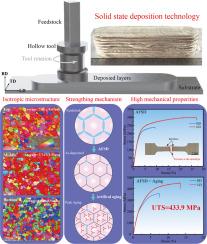添加搅拌摩擦沉积Mg-Gd-Y-Zr合金的组织演变及时效强化机制
IF 13.8
1区 材料科学
Q1 METALLURGY & METALLURGICAL ENGINEERING
引用次数: 0
摘要
固态沉积增材制造技术在制备高强度稀土镁(Mg-Re)合金部件方面具有成形温度低、致密化程度高、成分均匀、效率高等显著优势。采用加性搅拌摩擦沉积(AFSD)法制备了平均层厚为4 mm的Mg-8Gd-3Y-0.5Zr合金高强度单道次多层构件。结果表明:AFSD组件的上、中、下三个区域的显微组织为等轴晶,平均晶粒尺寸约为7.42±0.58µm;在肩带和给料的共同作用下,界面区经历了两阶段的塑性变形,形成了较细的等轴晶,平均晶粒尺寸约为2.79±0.14µm。经225℃人工时效20 h后,材料内部均匀分布有大量纳米β′析出相。建筑方向抗拉强度达到355.52±3.21 MPa,纵向抗拉强度达到433.91±2.31 MPa,分别比AFSD试样提高了49.0%和45.9%。时效处理后,层间和界面均未见晶粒长大。人工时效处理产生的纳米β′相是提高堆积层抗拉强度的关键因素。主要强化机制为沉淀强化和晶粒细化,对整体强化效果的贡献率分别为54.8%和26.7%。这些发现表明,AFSD为大规模Mg-Re合金部件的制造提供了一种新颖而有效的解决方案。本文章由计算机程序翻译,如有差异,请以英文原文为准。

Microstructure evolution and age-strengthening mechanism of Mg-Gd-Y-Zr alloy fabricated by additive friction stir deposition
Solid-state deposition additive manufacturing technology demonstrates significant advantages in fabricating high-strength rare-earth magnesium (Mg-Re) alloy components, including low forming temperature, high densification, uniform composition, and high efficiency. Here, a high-strength single-pass multilayer Mg-8Gd-3Y-0.5Zr alloy component was fabricated by the additive friction stir deposition (AFSD) method with an average layer thickness of 4 mm. The results indicate that the microstructures of the top, middle, and bottom regions of the AFSD component were equiaxed grain, with an average grain size of approximately 7.42 ± 0.58 µm. The interface region underwent two stages of plastic deformation under the separate effects of the shoulder and the feedstock, finer equiaxed grains were formed, with an average grain size of about 2.79 ± 0.14 µm. After artificial aging at 225 °C for 20 h, a large number of nano-β′ precipitates are uniformly distributed within the material. The ultimate tensile strength reached 355.52 ± 3.21 MPa in the building direction and 433.91 ± 2.31 MPa in the longitudinal direction, there is an increasing of 49.0 % and 45.9 % compared to the AFSD samples. No grain growth was observed in the interlayer and the interface after aging treatment. The finely dispersed nano-β' precipitates produced by artificial aging treatment are the key factor to improve the tensile strength of the deposited layer. The primary strengthening mechanisms were identified as precipitation strengthening and grain refinement, contributing 54.8 % and 26.7 % to the overall strengthening effect, respectively. These findings suggest that AFSD offers a novel and efficient solution for the fabrication of large-scale Mg-Re alloy components.
求助全文
通过发布文献求助,成功后即可免费获取论文全文。
去求助
来源期刊

Journal of Magnesium and Alloys
Engineering-Mechanics of Materials
CiteScore
20.20
自引率
14.80%
发文量
52
审稿时长
59 days
期刊介绍:
The Journal of Magnesium and Alloys serves as a global platform for both theoretical and experimental studies in magnesium science and engineering. It welcomes submissions investigating various scientific and engineering factors impacting the metallurgy, processing, microstructure, properties, and applications of magnesium and alloys. The journal covers all aspects of magnesium and alloy research, including raw materials, alloy casting, extrusion and deformation, corrosion and surface treatment, joining and machining, simulation and modeling, microstructure evolution and mechanical properties, new alloy development, magnesium-based composites, bio-materials and energy materials, applications, and recycling.
 求助内容:
求助内容: 应助结果提醒方式:
应助结果提醒方式:


